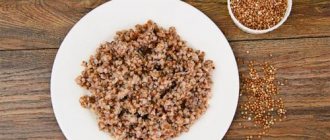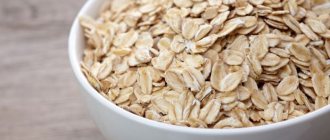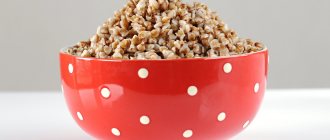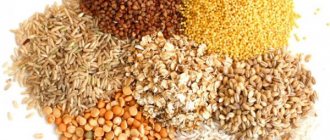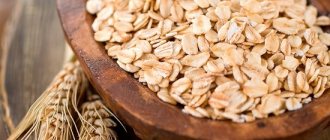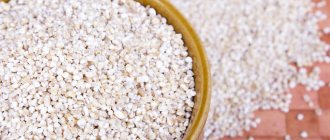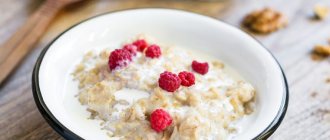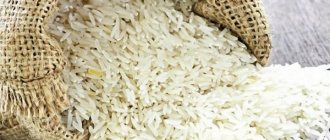Author: Kristina Lobanovskaya, doctor, practicing nutritionist Article updated: 11/09/2020
Semolina porridge is a well-known dish that all children of the Soviet era had for breakfast. Today it is still considered “children’s”, but its benefits have been questioned by experts. Not everyone will decide to lose weight on such a product either, and all because of the calorie content of semolina porridge: according to most people, it has too high an energy value. Is this really so and what is the calorie content of the product in one form or another?
Dry
Porridge is prepared from semolina, which is nothing more than finely ground wheat. The diameter of the grains ranges from 0.25 to 0.75 mm. The cereal quickly boils, again, thanks to grinding, and is perfectly absorbed by the body. Due to its minimal fiber content, liquid semolina porridge is recommended to be included in the diet in the presence of diseases of the gastrointestinal tract. This is one of the first beneficial properties of cereals. In addition, semolina fills the body with energy, helps restore physical strength, and also cleanses and removes fat.
Despite the lack of fiber, the composition of the cereal is quite diverse. It contains starch, proteins, vitamins E and group B, as well as many minerals. It also contains gluten, known as gluten. Gluten is viewed controversially by most scientists because it leads to thinning of the intestinal mucosa and interferes with the absorption of nutrients. In addition, it is “gluten” that often causes allergies. Another very controversial substance in cereals is phytin. It has the ability to bind calcium salts, preventing its absorption. And yet, such moments do not negate the benefits and excellent taste of porridge. For a long time, semolina has been popular all over the world.
Semolina is used relatively infrequently as a product for weight loss, which is due to its high calorie content compared to other cereals - 333 kcal for every 100 grams. However, you should know that after cooking, cereal loses a significant part of its calories, so it becomes quite appropriate on the dietary table.
Since no one eats semolina in dry form, it is a mistake to consider it a high-calorie product.
The main thing to achieve the effect and benefit is to follow a number of simple rules when choosing a product:
- Choose cereal in a plastic bag, since such packaging prevents it from coming into contact with moisture.
- Give preference to porridge that has the “GOST” mark on its packaging.
- Purchase only clean goods, without suspicious impurities.
After purchasing, the cereal must be transferred to a glass container and sealed tightly. In this case, its shelf life can be extended to 10 months.
What is semolina made from?
The raw material for semolina is wheat, a grassy cereal widely cultivated throughout the world. This cereal plant is distinguished by its variety of species and varieties.
One of the main parameters for the classification of wheat, the main cereal in the world, is the structure of the ripened grain. It can be mealy, glassy or combined, combining both characteristics. Accordingly, semolina from different varieties of wheat will have differences in composition and properties.
The type of cereal semolina is made from is indicated by the marking:
- T – from durum wheat varieties, which are distinguished by better grinding characteristics and excellent culinary qualities.
- M – from soft varieties. It has less protein, fiber and a higher starch content.
- MT - as a rule, from a mixture of soft and durum wheat varieties (in a ratio of 4:1) or from one whose grains are not uniform in structure.
The most common semolina is the “MT” category.
On the water
Semolina porridge cooked in water, especially without the use of butter and other additives, is an excellent dietary product that can be consumed if you want to cleanse the body and normalize the functioning of the digestive tract. Unlike a dry product, it is completely harmless to the figure: the calorie content of semolina porridge with water is 80 kcal per 100 grams. The dish is considered a good alternative to milk porridges for those who suffer from lactose intolerance. If you add sugar during the cooking process, the calorie content will increase to 120 kcal per 100 grams. When preparing porridge in water without sugar, but with butter, the calorie content is 101 kcal per 100 grams. To give “lean” porridge a rich taste and nutritional value, you can use both ingredients at once. The calorie content of porridge with sugar and butter is 137 kcal per 100 grams, which is also quite acceptable for a weight loss diet.
Semolina is a source of valuable proteins. Its use along with regular physical activity can significantly transform your figure.
Like cereals, ready-made semolina supplies the body with vitamins and minerals, which helps prevent many diseases. Experts note that eating “lenten” semolina is a sure way to normalize the activity of the nervous system, produce blood cells and obtain energy for the full functioning of the whole body. It has been proven that even a small portion of this porridge helps relieve pain and cramps from ulcers and gastritis.
The classic recipe for making porridge with water provides a ratio of 1:4 (medium-thick semolina). There are several cooking methods: you can pour the cereal into cold water and cook for several minutes after boiling, or pour it into boiling water and boil for no more than 1 minute. The main thing is to stir vigorously to avoid lumps. The finished product should be stored in the refrigerator, but it is better to consume it immediately after preparation.
Semolina in cooking
Semolina in the form of porridge is the most famous, but far from the only dish made from semolina.
It is also used to prepare:
- first courses in the form of filling (coarsely ground category T cereals);
- dumplings (small ones will do);
- cereal casseroles (as a main or additional ingredient);
- pancakes, cheesecakes, cottage cheese casseroles (as a thickening component);
- biscuit-type pies (manna);
- cutlets and other minced meat products (both the ingredient added directly to the minced meat and the type of breading).
The neutral taste of semolina allows it to be combined with almost any set of foods: berries, fruits, nuts, meat, etc.
With milk
Semolina cooked with milk turns out nutritious and tender. It contains simple carbohydrates that give you quick satiety and a burst of energy. It is absorbed almost completely, without injuring the stomach. All thanks to the lack of fiber - there is no more than 2% of it in the product.
Despite the large amount of simple carbohydrates, the dish can be used for weight loss. Experts have even developed several special diets, one of which involves consuming exclusively milk semolina.
The calorie content of semolina porridge with milk is only 98 kcal, which is not much higher than that cooked in water. You can increase your calorie content with additional ingredients:
- with sugar but without butter – 101 kcal per 100 g;
- with butter, without sugar – 155 kcal per 100 g;
- with butter and sugar – 113 kcal per 100 g.
It should be borne in mind that when losing weight, you should not use the fattest milk and try not to overload the porridge with butter, adding a small piece when serving.
There is another interesting option for preparing semolina for those who are not ready to give up milk - cooking with milk and water (in a dairy farm). Liquid components are taken equally. The calorie content of such a dish is at the level of 80 kcal per 100 g. If you add a little sugar additionally, the calorie content will increase to 107 kcal for every 100 g.
The process of preparing semolina in milk is similar to the method of boiling in water, that is, the cereal can be poured into cold or boiling liquid. Intensive stirring is necessary.
Difference between semolina and wheat cereal
Semolina and wheat are the most common cereals made from wheat grains.
Despite the same starting raw materials, different degrees of grain grinding result in different cereals with different compositions and characteristics:
| Sign | Semolina | Wheat groats |
| Color | White and yellowish cream | Grey, taupe |
| Size of crushed grain fractions | 0.25 - 0.75 mm | 1.5 – 3.5 mm |
| Cooking time | 1-2 minutes | 15-20 minutes |
Both cereals are obtained from different varieties of wheat. The highest quality cereals are produced from solid grains, both the most convenient for culinary processing and the most useful in terms of their chemical composition.
The most valued advantages of semolina in society are the consistency of the porridge, its neutral taste and speed of preparation.
Dishes
Semolina porridge is not only a complete food product that can be supplemented with fruits, vegetables, etc., but also an ingredient for creating quite unexpected dishes. The delicate taste of the finished porridge can diversify your daily and dietary diet.
Baked
The classic recipe for making semolina involves boiling, but baked porridge turns out much more appetizing. The calorie content of the finished product is not low - about 339 kcal per 100 g, but it satisfies quickly and for a long time.
To prepare a volume suitable for 6 servings, take 2 cups of regular oatmeal without additives. In a bowl, combine with a glass of low-fat yogurt, again without additives. Mix well and add 1 cup of semolina. After 30 minutes, add one raw chicken egg and 100 g of steamed raisins. Add half a cup of granulated sugar. Mix thoroughly. The baking dish is greased with vegetable oil. Place the mass in it and cook at a temperature of 180 degrees for 40 minutes.
With banana
Semolina with banana is ideal for breakfast. The sweet fruit gives the porridge an unexpected taste without adding much calories - 116 kcal per 100 g. The dish is prepared using milk, which makes it nutritious and tender.
Pour a glass of cold milk into the pan and add 2 tablespoons of semolina. Bring to a boil over low heat and cook for another 3 minutes with constant stirring. Place a tablespoon of granulated sugar and a finely chopped sprig of rosemary on a hot frying pan. Banana cut into slices is also sent there. To prevent the banana from losing its shape, frying is done quickly. Semolina is poured into a plate, and a fragrant caramel banana is placed on top.
The dish not only saturates the body with vitamins and minerals, but consuming it in the morning will prevent problems with the cardiovascular system and improve the digestion process. This is all thanks to the potassium content in bananas.
With dried apricots and raisins
A diet based on semolina porridge gives excellent results, but not everyone can use it regularly, and even in its classic form. The recipe with dried apricots and raisins is just for those. With a relatively low calorie content - 154 kcal per 100 g - and nutritional value, the dish provides gastronomic pleasure. By the way, this is one of the recipes for which “milk water” is used.
In a saucepan, combine a glass of water and low-fat milk. Add 2 tablespoons of granulated sugar and 1 teaspoon of salt. Place on fire, stir and heat, but do not bring to a boil. Remove from heat. 70 g of large raisins and 100 g of dried apricots are thoroughly washed and soaked for 20 minutes in warm water, then squeezed and crushed. The milky liquid is returned to the fire and heated. Add 1 cup of semolina and stir quickly to prevent the formation of lumps. Without ceasing to stir, add dried apricots and raisins. Stir until the semolina completely thickens. Remove from heat, cover with a lid and leave to steep for 15 minutes.
The dried fruits used in the recipe give the finished product a special taste and help increase its benefits for the body. Firstly, it becomes possible to increase the level of hemoglobin in the blood and have a positive effect on the functioning of the heart muscle. Secondly, prevent disorders in the functioning of the nervous system and improve sleep.
With carrots
Semolina is equally good in combination with fruits and vegetables. Adding carrots is a great way to fortify a dish. The vegetable is recommended for bronchitis, anemia, and vision diseases. In addition, it is an antiseptic, choleretic, analgesic and anti-inflammatory natural remedy that additionally strengthens hair and normalizes complexion. 100 g of semolina with carrots contains only 119 kcal, so it is suitable for use when losing weight.
Place a small piece of butter in a saucepan. Wait for it to heat up and add a little sugar. Grate the carrots on a fine grater and place in a saucepan. Simmer for about 5 minutes with constant stirring. A glass of warm milk is added to the carrots. After a few minutes, gradually add 2 tablespoons of semolina. Stir and cook for 4 minutes.
Chocolate
Cocoa powder will help transform a dish from a tasteless white mass into a gastronomic pleasure. Additionally, the recipe includes raspberries, due to which the semolina is saturated with even more vitamins. The dish looks especially useful for people with low immunity and impaired metabolism. Cocoa also has benefits, as it contains a large amount of antioxidants.
Pour 2 cups of milk into a saucepan. Heat, add 2 tablespoons of sugar and a pinch of salt. Pour 3 tablespoons of cereal into well-warm, but not boiling milk. Cook, stirring constantly, for 5 minutes. Add 2 tablespoons of cocoa powder and cook for another 1 minute. Once cooking is complete, add a handful of fresh or frozen raspberries.
Dessert
If you have ready-made milk semolina left in the refrigerator, you can use it to prepare an unusual dessert, the calorie content of which is 149 kcal per 100 g. For those losing weight, the dish looks like a good alternative to high-calorie baked goods.
Heat 500 g of semolina, add 20 g of butter and let it dissolve, then mix. Take a deep plate and moisten it with a small amount of water. Place a tablespoon of cherry jam on the bottom, then cover with half a portion of semolina. Then again there is a layer of jam, but this time from 2 tablespoons. Spread the remaining porridge on top. Cover the plate with foil and put it in the refrigerator for 2 hours. After the time has passed, the foil is removed and the plate is turned over onto a plate. Sprinkle the dessert with a few teaspoons of cocoa powder.
Recipes for facial care
The unique properties of semolina are successfully used in cosmetology to restore, soften, whiten, moisturize and nourish the skin.
Cream
An excellent product with a rejuvenating effect.
- Boil 3 tbsp in milk. l. semolina, strain the mixture through 3 layers of gauze. Add 1 tsp. shea butter, 2 drops of rose oil, mix the composition.
- Apply a thin layer of the product to your face before going to bed. Can be used as a massage product.
Store the cream unopened for no more than a week.
Anti-wrinkle mask
A simple and affordable way to care for your face at home.
- Combine 1 tbsp in a bowl. l. semolina, liquid natural honey, yogurt (without additives). Mix the ingredients, leave the cereal to swell until a viscous consistency is formed;
- Apply the composition to the pre-steamed dermis, hold for 15–25 minutes, then wash with warm water. Lubricate the skin with moisturizer.
Arrange treatments every 3-4 days for 6-8 weeks.
Firming mask
The resulting composition, when used regularly, has an effective tightening result.
- Combine 25 g of semolina with 2-3 tbsp. l. cream or sour cream, mix thoroughly, let stand until the cereal swells.
- Apply the mixture with light massage movements onto the skin of the face and décolleté. Leave for 15–20 minutes. You should not keep the mask on for longer so as not to cause skin irritation;
- Rinse off the composition alternately with warm and cool water, then use an emollient cream.
Repeat sessions 1-2 times a week. Eating semolina can bring both undoubted benefits and cause some harm to human health. A balance of interests is possible provided that this truly unique cereal product is used wisely.
The nutritional value
The benefits of semolina porridge lie in the vitamin and mineral composition of the cereal itself. Despite the fact that its value in comparison with other cereals is small, the calories are not “empty” at all. In addition to enveloping starch, semolina contains saturated fatty acids, mono- and disaccharides. Since semolina is a product of wheat processing, it contains much more protein than other cereals - as much as 12%. The dish is considered very suitable for athletes and people accustomed to leading an active lifestyle. It is not for nothing that semolina is classified as a product suitable for mono-diets: it contains all the substances necessary for the body, so additives can only be used to diversify the taste.
Proteins fats carbohydrates
The ratio of BJU depends on the method of preparing the porridge and the additional products used in the process, however, carbohydrates are the main source of energy for the human body.
Dry semolina, known as a high-calorie product, has the following BJU indicators:
- proteins – 10.3 g;
- fats – 1 g;
- carbohydrates – 70.6 g.
When boiled in water, the calorie content decreases, and significantly. BZHU indicators are also undergoing changes:
- proteins – 2.5 g;
- fats – 3.2 g;
- carbohydrates – 16.8 g.
At the same time, adding sugar slightly increases the level of proteins (3.2 g) and reduces the level of carbohydrates (15 g). If you use butter, the latter will be even larger - 19.7 g. You can also add both ingredients at the same time, obtaining the following indicators for every 100 g:
- proteins – 3.7 g;
- fats – 4.1 g;
- carbohydrates – 18.1 g.
The calorie content of a 100 gram serving of semolina cooked in milk is 98 calories. The BJU ratio is as follows:
- proteins – 1.6 g;
- fats – 2.7 g;
- carbohydrates – 11.5 g.
If you add sugar, the calorie content will increase to 101 kcal. The BZHU indicators will also change slightly:
- proteins – 3.2 g;
- fats – 2.7 g;
- carbohydrates – 16.5 g.
The calorie content of semolina porridge with butter, cooked in milk, is 155 calories per 100 grams. If you want to do without sugar, the ratio will be as follows:
- proteins – 4.1 g;
- fats – 7.9 g;
- carbohydrates – 17.8 g.
Semolina can be cooked with milk using both components, which will also affect the calorie content - 113 kcal - and BJU indicators:
- proteins – 3.1 g;
- fats – 5.7 g;
- carbohydrates – 12.5 g.
When cooking cereal in a “milk tank”, the calorie content of a 100 gram serving will be 80 calories. The dish will have the following meanings:
- proteins – 2.3 g;
- fats – 1.3 g;
- carbohydrates – 12.3 g.
Baked semolina with the addition of oatmeal and raisins has a high calorie content - 339 kcal for every 100 grams and includes:
- proteins – 8 g;
- fat – 6 g;
- carbohydrates – 65 g.
Macro- and microelements
Semolina is a storehouse of minerals important for the body. Along with the most well-known and familiar to humans, such as calcium and iron, it contains unexpected minerals that play an important role in providing benefits to all organs and systems.
- Titanium – takes part in the formation of red blood cells in the bone marrow, supports the immune system and is involved in the synthesis of hemoglobin.
- Tin – enhances growth processes, promotes proper skeletal development, and is part of gastric enzymes.
- Nickel - activates a number of enzymes, participates in fat metabolism and enhances the passage of redox processes in tissues, that is, it provides them with oxygen.
- Aluminum – increases the digestive ability of gastric juice, takes part in the construction of bone and connective tissue, and helps in epithelization of the skin.
- Cobalt - participates in the process of hematopoiesis, regulates the functioning of the central nervous system, normalizes the activity of the pancreas.
- Silicon - affects brain function, helps lower blood pressure, normalizes metabolism (acts as a catalyst for multiple redox processes).
- Vanadium – supports the cardiovascular system, is involved in the regulation of carbohydrate metabolism and has a beneficial effect on the functions of the liver and kidneys.
- Boron - improves the metabolism of calcium, fluorine and phosphorus, while participating in the regulation of the nervous system and enzymatic processes.
- Molybdenum – promotes the metabolism of fats, carbohydrates and proteins, while normalizing sexual function and stimulating body growth.
- Fluoride – strengthens the bone skeleton and tooth enamel, increases the body’s defenses, and suppresses the activity of pathogens.
- Chromium – regulates the functioning of the cardiovascular system and thyroid gland, helps prevent the development of osteoporosis.
- Manganese – improves the functioning of the central nervous system, participates in the metabolism of vitamins E and C, and has antioxidant properties.
- Copper – participates in hematopoiesis processes, normalizes the functioning of the endocrine system, improves digestion.
- Zinc – regulates the functioning of the central nervous system and gonads, helps in the rapid healing of wounds.
- Iron – participates in intracellular metabolic processes, affects the metabolism of B vitamins, and ensures the transport of oxygen in the body.
- Sulfur – strengthens muscle tissue, helps in removing waste and toxins from the body, stabilizes blood sugar levels.
- Chlorine – helps eliminate swelling and remove toxins from the body, helps in the breakdown of subcutaneous fat, and improves the functioning of the liver.
- Phosphorus - is important for kidney health and metabolism, activates the action of vitamins, is necessary for normal heart function, strengthens teeth and gums.
- Potassium is extremely important for maintaining heart health and normal functioning of soft tissues, and helps eliminate swelling.
- Magnesium – is involved in the functioning of the central nervous system, improves the functioning of the digestive organs, and supports heart health.
- Calcium – helps strengthen the bone skeleton and teeth, has an anti-allergenic effect, and has an anti-stress effect.
The mono-diet on semolina is well tolerated precisely because of the huge amount of minerals included in its composition, which act together.
Vitamins
Despite the fact that semolina cannot boast of a wide list of organic compounds, it contains the content of the most important vitamins for the health of the body, mainly group B:
- PP (niacin or B3) – is involved in the metabolism of amino acids, fats and proteins, and is additionally considered an important component of tissue respiration and redox processes.
- E (tocopherol) – is a powerful antioxidant, supports the immune system, improves cellular nutrition.
- B9 (folic acid) – actively participates in the regulation of the functions of the hematopoietic organs, has a positive effect on the functioning of the liver and intestines.
- B6 (pyridoxine) – lowers cholesterol levels, improves the contractility of the heart muscles, and promotes better absorption of glucose by nerve cells.
- B2 (riboflavin) - acts as a participant in all types of metabolic processes, plays an important role in the functioning of the visual organs.
- B1 (thiamine) – is involved in fat, carbohydrate, water-salt and energy metabolism, and also improves the condition of the cardiovascular and nervous systems.
To get the maximum benefit from semolina porridge, it is enough to eat just one serving a day - 250 grams. It is better if it is prepared without harmful additives in milk. Since this is the only cereal that can cleanse the intestines of mucus, its use is definitely useful for those who want to put all organs of the gastrointestinal tract in order. There are also pitfalls of regularly including the dish in your diet. For example, a high gluten content can provoke an allergic reaction and interfere with the absorption of nutrients from food. When deciding to use semolina as a diet product for weight loss, this should be taken into account first. Semolina is also a morning product, so it is better to refrain from consuming it in the evening.
For adult health
It is believed that semolina porridge is most often intended for children, which is not entirely correct. Dishes containing this product are equally useful for adults, including the elderly. The use of the product will add strength in case of chronic fatigue and general weakness, and will prevent the development of tumors. The minimum protein content is indicated in the presence of renal failure.
However, frequent consumption of such porridge can cause brittle bones and nails in older people and cause fragility of tooth enamel.
Semolina porridge is the only product whose digestion, assimilation and absorption occurs in the lower intestine. The absence of cholesterol in cereals affects the reduction and normalization of blood pressure. Gastroenterologists recommend semolina dishes to patients suffering from stomach ulcers, gastritis, and other gastrointestinal pathologies. Such foods control the secretion of acid and gastric juice.
The use of the product by pregnant women is indicated no more than 3 times a week. Cooked food helps expectant mothers suffering from constipation, gently eliminating such an unpleasant problem. The peculiarities of the composition of the cereal ensure complete absorption of all substances in a short period of time without the unpleasant sensations of oversaturation and discomfort in the stomach. Taking this dish for breakfast has a cleansing effect on the body.
